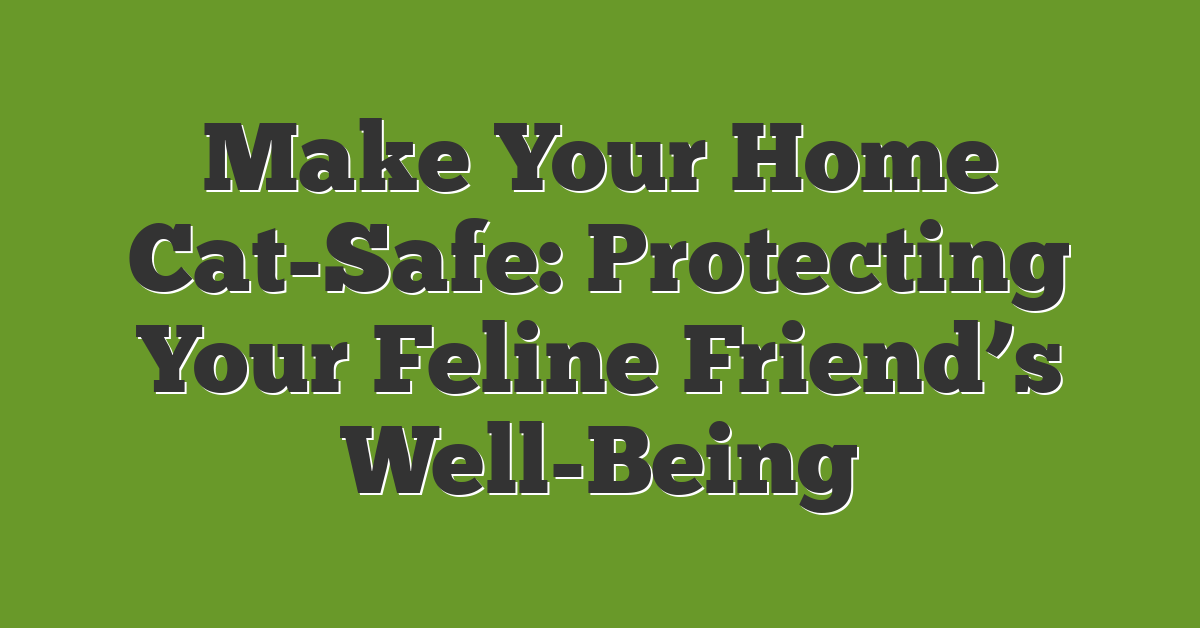The Mysterious World of Cat Behavior
As a cat lover, you may have observed some really strange behaviors in your feline friend. But have you ever wondered what these behaviors mean? Cats have their own unique way of communicating with us and understanding their world can be quite fascinating. Let’s dive into the mysterious world of cat behavior!
Zooming Around the House
Have you ever seen your cat suddenly sprinting around the house for no apparent reason? This high-energy burst is known as “zoomies.” Cats engage in this behavior as a way to release pent-up energy and to exercise their muscles. It’s a natural instinct that allows them to simulate hunting and play. So, when you see your cat chasing invisible prey, don’t be alarmed; they’re just having some fun!
Staring at Blank Walls
You might have caught your cat staring at a blank wall as if they’re seeing something that you can’t. Rest assured, your cat is not seeing ghosts! Cats have superior vision, and they can pick up on even the slightest movement or change in light. Their keen eyesight enables them to spot insects, dust particles, or even reflections that we may not be aware of. So, the next time you see your cat fixated on a wall, they’re just keeping an eye out for any potential prey.
Kneading on Soft Surfaces
If you’ve ever been lucky enough to experience your cat kneading on your lap or a cozy blanket, you may wonder why they do it. Kneading, also known as “making biscuits,” is a behavior that kittens inherit from their nursing behavior. It involves rhythmically pushing their paws in and out against a soft surface, like dough being kneaded. It’s a sign of contentment and satisfaction. So, when your cat kneads on you, consider it a loving gesture.
Obsession with Boxes
Cats seem to have an inexplicable fascination with boxes. Whether it’s a shoebox or a cardboard container, they can’t resist hopping in and claiming it as their own. Why is that? Boxes provide a sense of security and a hiding place for cats to observe their surroundings without feeling vulnerable. It taps into their instinctual need for safety, making them feel protected and enabling them to relax. So, next time you receive a package, be ready to share it with your furry friend!
Exploring the Peculiarities of Feline Antics
Cats, oh how they captivate us with their mysterious antics! As a dedicated cat lover, you’ve probably observed some peculiar behaviors that leave you scratching your head in wonder. Let’s delve deeper into the world of feline antics and unravel the reasons behind their quirky actions.
“Zoomies” – The Burst of Feline Energy
Have you ever witnessed your cat suddenly darting around the house like a lightning bolt, seemingly possessed by an unexplainable energy? These bursts of energy, known as “zoomies,” are quite common among our feline friends. Zoomies are a way for cats to release pent-up energy and simulate the thrill of hunting. It’s their way of expressing their natural instinct to chase after prey. So, next time your cat goes into full zoomie mode, embrace the chaos and appreciate their playful nature.
The Fascination with Blank Walls
Have you ever found your cat gazing intently at a blank wall, seemingly entranced by something that is invisible to your human eyes? Rest assured, your feline companion is not losing their mind. Cats possess remarkably sharp vision, far superior to ours. When they stare at blank walls, they may be detecting the tiniest movements, such as insects or reflections. So, the next time your cat stares at a wall, remember, they are simply in tune with their incredible feline instincts.
Kneading – The Happy Cat Ritual
Perhaps you’ve noticed your cat rhythmically kneading their paws on a soft surface, like a cozy blanket or your lap. This adorable behavior, known as kneading, is a sign of contentment and satisfaction. During their infancy, kittens knead their mother’s belly to stimulate milk flow. As adults, kneading serves as a reminder of those warm and nurturing times. So, when your cat kneads on your lap, feel honored by the love and trust they’re expressing.
The Fascinating Psychology Behind Kneading Behaviors
Why do cats knead? This peculiar behavior is not only endearing but also holds deep-rooted significance in a cat’s psychology. Let’s explore the intriguing reasons behind this quirk.
1. Reminiscing Their Kittenhood
When kittens nurse, they instinctively knead their mother’s belly to stimulate milk flow. As cats grow older, this behavior remains ingrained in their memory. So, when your furry friend kneads on a soft surface like a blanket or your lap, they are reenacting those nurturing times as kittens. It’s their way of expressing contentment and satisfaction.
2. Claiming Their Territory
Kneading isn’t just about comfort; it’s a form of marking territory too. Cats have scent glands in their paws, and as they knead, they release their unique scent onto the surface. This scent mark serves as a territorial signal, conveying to other cats that this space belongs to them. So, when you find your cat kneading on your favorite blanket, they are essentially claiming it as their own!
3. Relieving Stress and Anxiety
Kneading also has a therapeutic effect on cats. The rhythmic motion of their paws against a soft surface can help them relax and alleviate stress and anxiety. It mimics the feeling of a mother’s gentle touch, providing comfort and reassurance. So, if you see your cat kneading before settling down for a nap, they are simply finding solace in this soothing behavior.
Understanding the psychology behind kneading behaviors allows us to connect with our feline friends on a deeper level. Remember to provide your cat with plenty of soft surfaces, like blankets or beds, to indulge in their kneading instincts. It’s a beautiful way for them to express their emotions and find comfort in their surroundings.
So, next time you see those adorable little paws rhythmically working against a cozy blanket, take a moment to appreciate the fascinating psychology behind this charming behavior.
Unraveling the Mystery of Cats and Boxes
Do you ever wonder why cats are so obsessed with boxes? It’s a common behavior that has puzzled cat lovers for years. But fear not, my fellow feline enthusiasts! As a cat lover, expert, and aficionado, I’m here to shed some light on this intriguing phenomenon.
The Fascinating Allure of Boxes
You’ve probably experienced it yourself – you buy your cat an expensive toy, but it ends up playing with the box it came in instead. So, what’s the deal with boxes? Well, it turns out that cats have an innate love for enclosed spaces.
Boxes provide a sense of security and comfort for our furry friends. They offer a cozy retreat where cats can curl up, relax, and observe their surroundings from a safe vantage point. In the wild, small, enclosed spaces serve as perfect hiding spots for hunting or avoiding predators. This behavior is deeply ingrained in a cat’s instincts.
The Importance of Territory
Another reason why cats are drawn to boxes is their territorial nature. Cats have a natural instinct to mark their territory and claim it as their own. Boxes provide a small, defined space where they can establish their domain.
When a cat enters a box, they leave their scent behind, subtly marking it as their territory. This helps them feel secure and in control of their environment. It’s their way of saying, “This box is mine, and I feel safe here.”
The Joy of Play and Exploration
Beyond the instinctual reasons, boxes also offer cats plenty of opportunities for play and exploration. Boxes become their personal playgrounds, inviting them to pounce, hide, and stalk imaginary prey.
Jumping in and out of boxes satisfies a cat’s natural hunting instincts. It’s their way of honing their skills and keeping themselves mentally and physically stimulated.
Understanding Our Furry Friends
By unraveling the mystery of cats and boxes, we gain a deeper understanding of our feline companions. From their innate need for security and territory to their playful nature, boxes provide a fascinating insight into a cat’s behavior.
So, the next time you see your cat eyeing a plain cardboard box, embrace its allure and give them the joy of play. After all, who could resist the charming antics of a cat in a box?
Conclusion
Now you have a better understanding of some of the strange behaviors exhibited by cats. In this article, we explored the psychology behind two peculiar behaviors: kneading and the obsession with boxes.
Kneading is a behavior that holds deep-rooted significance in a cat’s psychology. It serves as a way for cats to express contentment and satisfaction, mark their territory, and find comfort and reassurance. By understanding why cats knead, you can better interpret their emotions and provide them with the care they need.
The mystery of why cats are obsessed with boxes was also unraveled. Boxes provide cats with a sense of security and comfort, allowing them to establish their territory. Additionally, boxes offer opportunities for play, exploration, and mental stimulation, satisfying their natural hunting instincts.
By embracing your cat’s love for boxes and understanding the psychology behind their behaviors, you can create a happier and more enriched environment for your feline friend. So, next time you see your cat kneading or diving into a box, remember that these behaviors are perfectly normal and serve important purposes in their world.
Frequently Asked Questions
1. Why do cats knead?
When cats knead, it is a behavior rooted in their psychology. They may knead to reminisce their kittenhood, claim territory, or relieve stress and anxiety. Kneading is a sign of contentment, satisfaction, and comfort for cats.
2. Why are cats obsessed with boxes?
Cats are often drawn to boxes because they provide a sense of security and comfort. Boxes also allow cats to establish their territory and satisfy their natural instincts for play and exploration. Additionally, boxes provide mental and physical stimulation for cats by allowing them to engage in hunting behaviors.
3. What does understanding the psychology behind cats and boxes allow us to do?
Understanding the psychology behind cats and their love for boxes provides insights into their behavior. It allows cat owners to embrace their cats’ affinity for boxes and provide them with opportunities for comfort, play, and mental stimulation.












